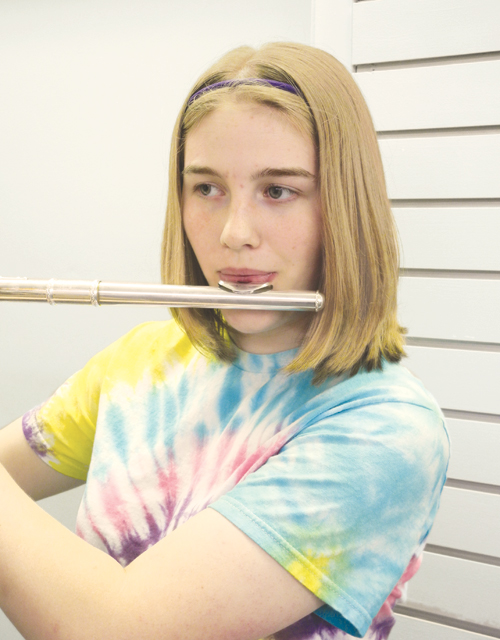
Teaching vibrato can be a daunting task, especially for someone who plays an instrument that does not use vibrato. It does not need to be. When starting a beginner, always play with vibrato, and as soon as you hear any hint of vibrato in the student’s playing, it is time to teach vibrato. Early signs of vibrato sometimes occur as early as the eighth or ninth week of lessons. Using the following instructions, teaching vibrato can happen in minutes; however, learning how to use vibrato artistically takes a lifetime.
Vibrato is a small fluctuation of the pitch (going sharper and then flatter) produced by the breath. This happens in the vocal folds just where you swallow.
Start by whistling silent staccato notes. There should be no movement in the abdomen or chest. Vibrato is slurring these whistled staccato notes together. Another option, one that uses the headjoint, is to play three breath attacks (no tongue) followed by a rest. A breath attack (no tongue) is the same as playing hah-hah-hah-rest staccato and very softly. If this exercise is done too loudly, the abdomen and chest will move. When vibrating, only the vocal folds move. Play hah-hah-hah-rest until the flutist can do so perfectly many times in a row. Then, slur the hahs.
If a student is having difficulty pulsing, without the headjoint, try sh-sh-sh-rest staccato and pp. However, with the sh sound there may be a tendency to move the abdomen or chest, so remember to keep the dynamic at the pp level.
Headjoint Exercises
Muscles learn in chunks of playing followed by a rest. Practice the following hah chunks first staccato and then followed by a slurred set. (MM=60-80.)
.jpg)
After a student is proficient in these patterns, then practice vibrato patterns with 02320 vibrato cycles per beat, 0234320 and 023454320 with the metronome. (MM=60-80.)
.jpg)
Good Things to Know
• In the high range, the vibrato speed is faster; in the low range, it is slower.
• When playing in a flute section (tutti), the vibrato should be less prominent than when playing a solo.
• A vibrato that is too fast and narrow on stage will sound like a straight sound in the audience, so think about imprinting the vibrato cycles.
• Vibrato starts at the beginning of the note. The vibrato cycle first goes to the sharp side of the pitch and then to the flat side. At the end of the phrase, leave the note while going toward the sharp side of the pitch.
• Artistic playing means varying the speed of the vibrato. Experiment with various speeds.
• When learning vibrato, use a beginning book or hymnal placing four vibratos per quarter. This is a good exercise to learn to subdivide the beat. In compound time, vibrato six pulsations to a dotted quarter note.
• Practice vibrato on a harmonic note. For example, finger a low D and overblow to the third partial, which will be an A. Practicing vibrato on a harmonic note (the A) has some built in resistance so that once the resistance is removed, the vibrato will flow more freely. Repeat on an Eb sounding a Bb, an E sounding a B, an F sounding a C, and so on. A harmonic note has some built in resistance, so once the resistance is removed, the vibrato will flow more freely.
• Color vibrato (a faster than usual cycle for tone coloring purposes) may be used on the first note of a slur, on any note with an accidental, on the note before a skip of an interval of a fourth or more, and on the highest/lowest note of the phrase.
• In modern usage, the vibrato is continuous. Practice scales with 2, 3, 4, 5, or 6 vibrato cycles per pitch. Do not let the vibrato stop when you change notes.
• He-Haw. If the vibrato is continually too slow, place the vibrato forward as if saying he. Likewise if it is too fast, place the vibrato back as if saying haw.






